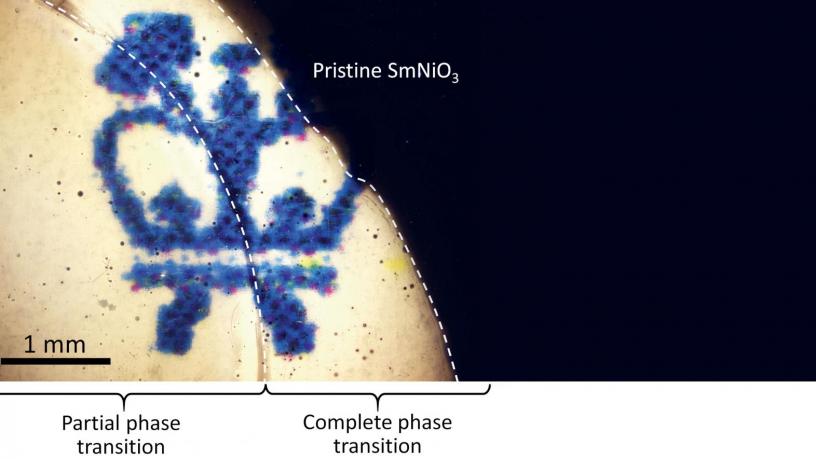From Smart Windows to Infrared Camouflage, New Optical Material Has Cloaking Potential
Columbia engineers are conducting some of the first demonstrations of a new phase-transition optical material that has the potential to transform optoelectronic technologies such as smart windows, infrared camouflage, and optical communications.

Using the Columbia Engineering logo, Nanfang Yu demonstrates how samarium nickelate (SmNiO3) can be tuned between transparent and opaque states. (Image courtesy of Nanfang Yu)
They discovered that samarium nickelate (SmNiO3) can be electrically tuned continuously between a transparent and an opaque state over an unprecedented broad range of spectrum, from the blue in the visible, with a wavelength of 400 nanometers, to the thermal radiation spectrum in the mid-infrared, with a wavelength of a few tens of micrometers.
“The performance of SmNiO3 is record breaking in terms of the magnitude and wavelength range of optical tuning. There is hardly any other material that offers such a combination of properties that are highly desirable for optoelectronic devices,” said Nanfang Yu, assistant professor of applied physics at Columbia Engineering. He leads the team that demonstrated for the first time how SmNiO3 could be used to dynamically control light over a much broader wavelength range and with larger modulation amplitude than is currently possible.
“The reversible tuning between the transparent and opaque states is based on electron doping at room temperature and is potentially very fast, which opens up a wide range of exciting applications,” Yu said.
For example, SmNiO3’s capability to control thermal radiation could lead to “intelligent” coatings for infrared camouflage and thermoregulation. These coatings could make people and vehicles appear much colder than they actually are so thermal cameras would not be able to discern them from the surrounding environment at night. They could also help reduce the large temperature gradients on a satellite by adjusting the relative thermal radiation from its bright and dark sides with respect to the sun and thereby prolong the life of the satellite. Because the material can potentially switch between the transparent and opaque states at high speed, it might also be used in modulators for free-space optical communication and optical radar and in optical memory devices.
Researchers have long been trying to build active optical devices that can dynamically control light. These include Boeing 787 Dreamliner’s “smart windows,” which partially control the transmission of sunlight, and high-data-rate, long-distance fiber optic communications systems where information is “written” into light beams by optical modulators.
When Shriram Ramanathan, associate professor of materials science at Harvard, discovered SmNiO3’s giant tunable electric resistivity at room temperature, Yu took note. In collaboration with Ramanathan, Yu and his students conducted initial optical studies of the phase-transition material; integrated the material into nanostructured designer optical interfaces, called “metasurfaces”; and created prototype active optoelectronic devices, including optical modulators that control a beam of light, and variable emissivity coatings that control the efficiency of thermal radiation.
“SmNiO3 is really an unusual material because it becomes electrically more insulating and optically more transparent as it is doped with more electrons—this is just the opposite of common materials such as semiconductors,” said Columbia PhD student Zhaoyi Li.
It turns out that doped electrons “lock” into pairs with the electrons initially in the material, a quantum mechanical phenomenon called “strong electron correlation,” and this effect makes these electrons unavailable for conducting electric current or for absorbing light. After electron doping, SmNiO3 thin films that were originally opaque suddenly allow more than 70 percent of visible light and infrared radiation to pass through.
One of the team’s biggest challenges was integrating SmNiO3 into optical devices. To make it work, they developed special nanofabrication techniques to pattern metasurface structures on SmNiO3 thin films.
“We envision replacing bulky optical devices and components with ‘flat optics’ by utilizing strong interactions between light and metasurfaces to control light at will,” Yu said. “The discovery of this phase-transition material and the successful integration of it into a flat device architecture are a major leap forward to realizing active flat optical devices not only with enhanced performance from the devices we are using today but with completely new functionalities.”
